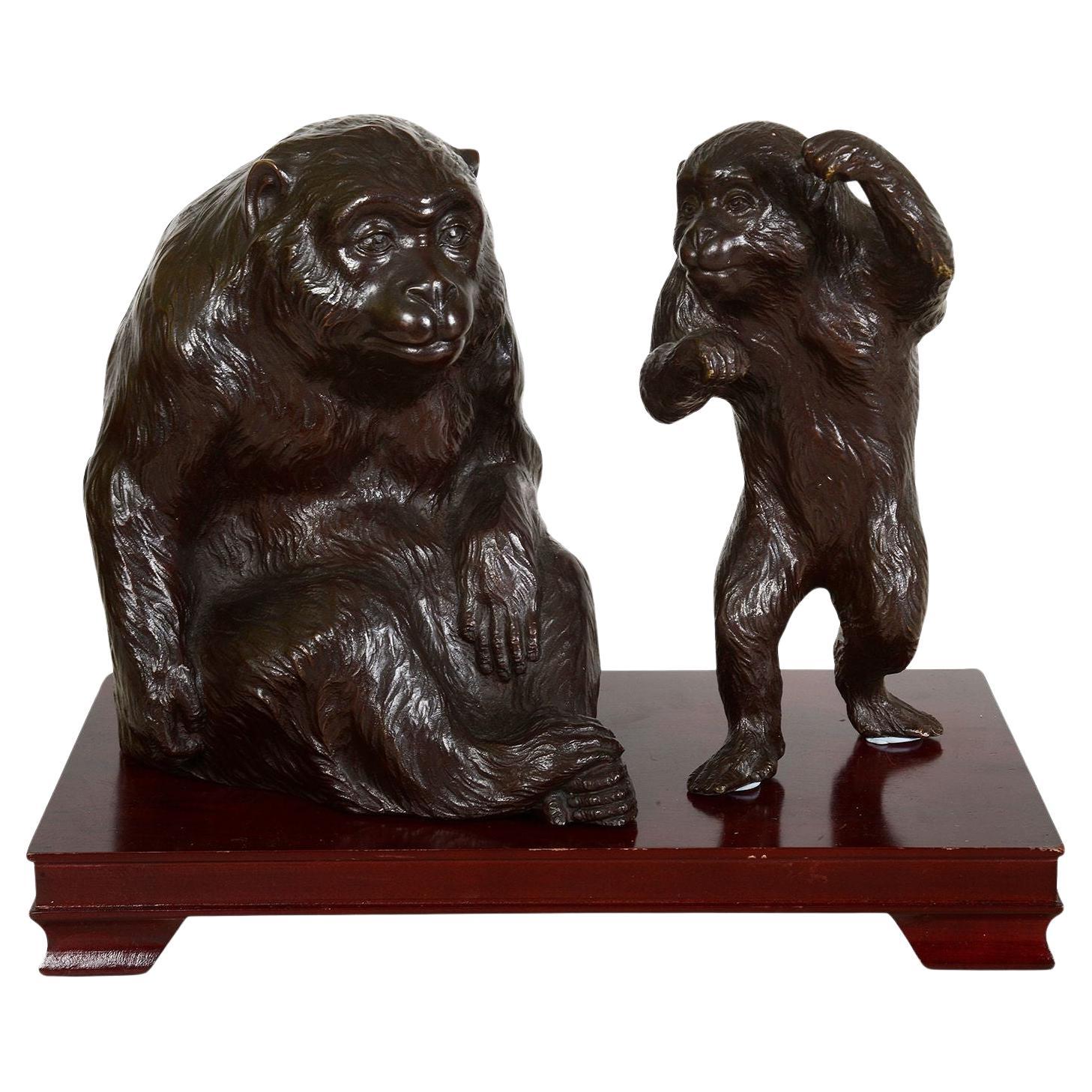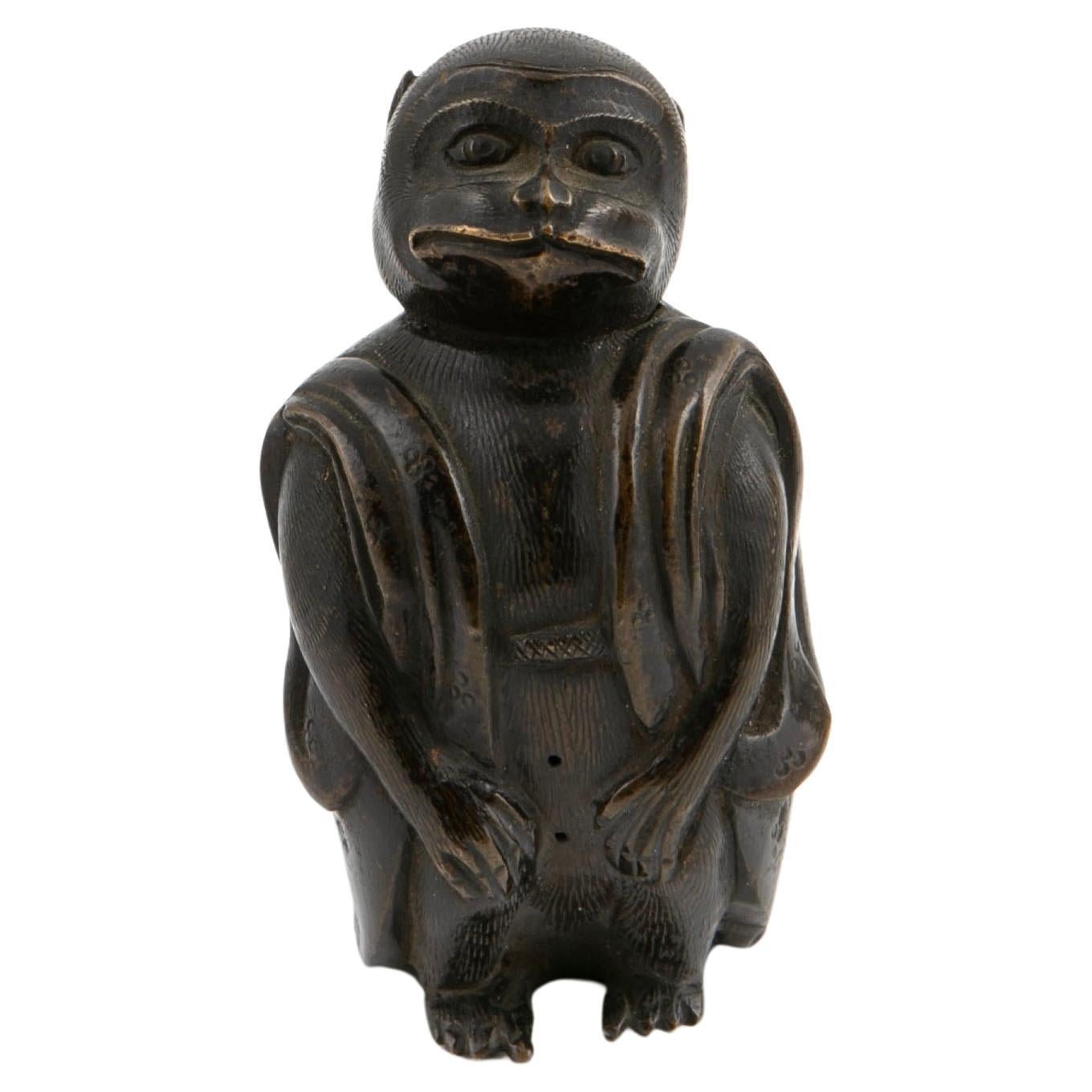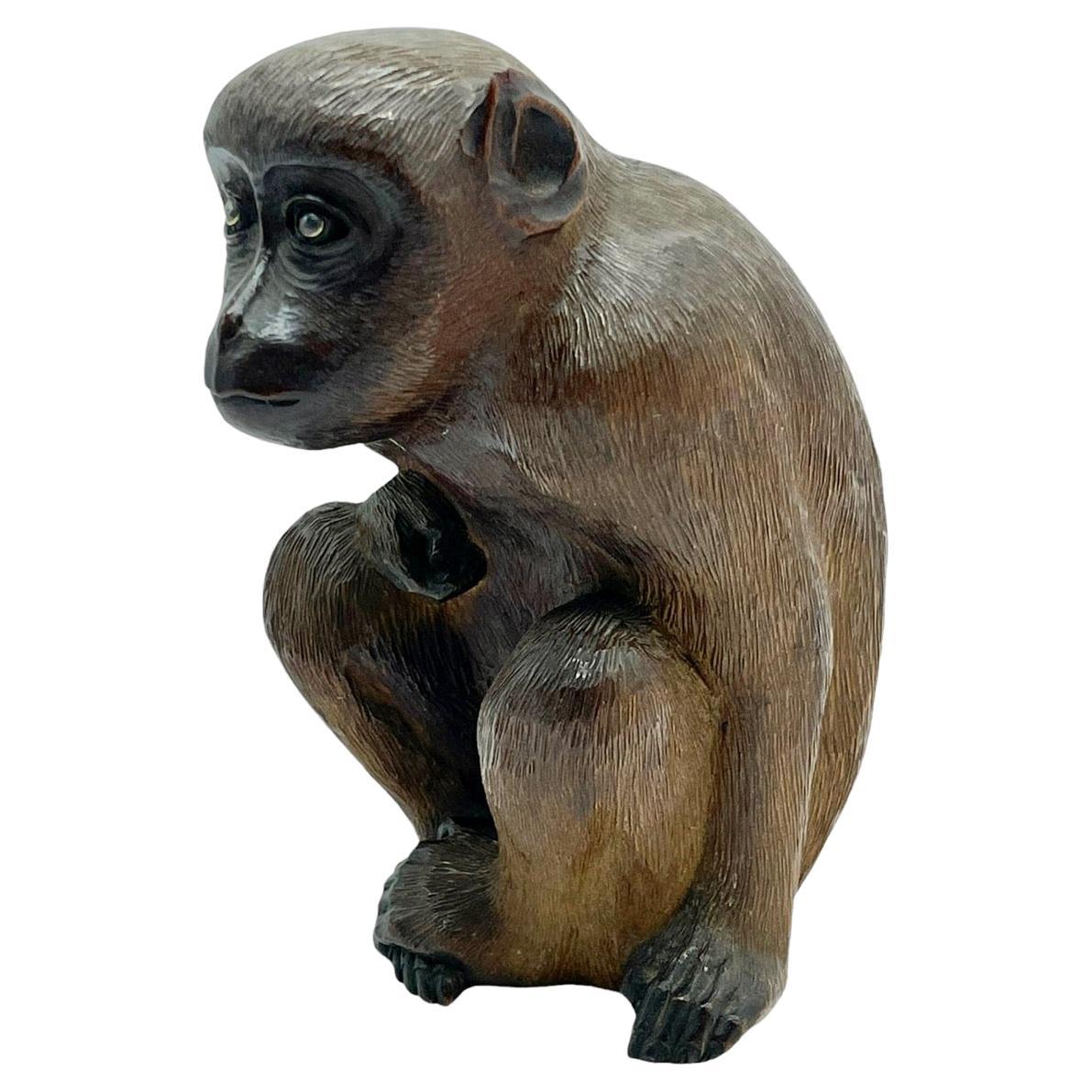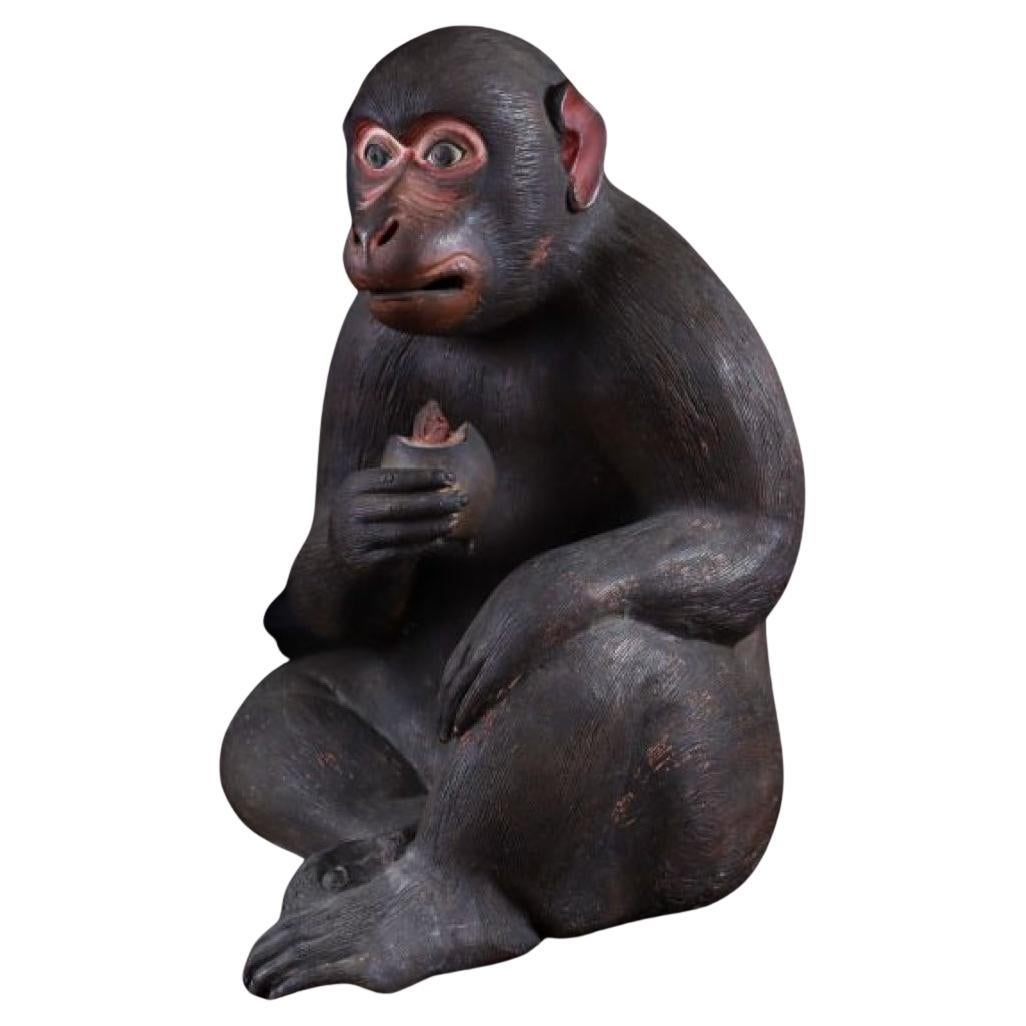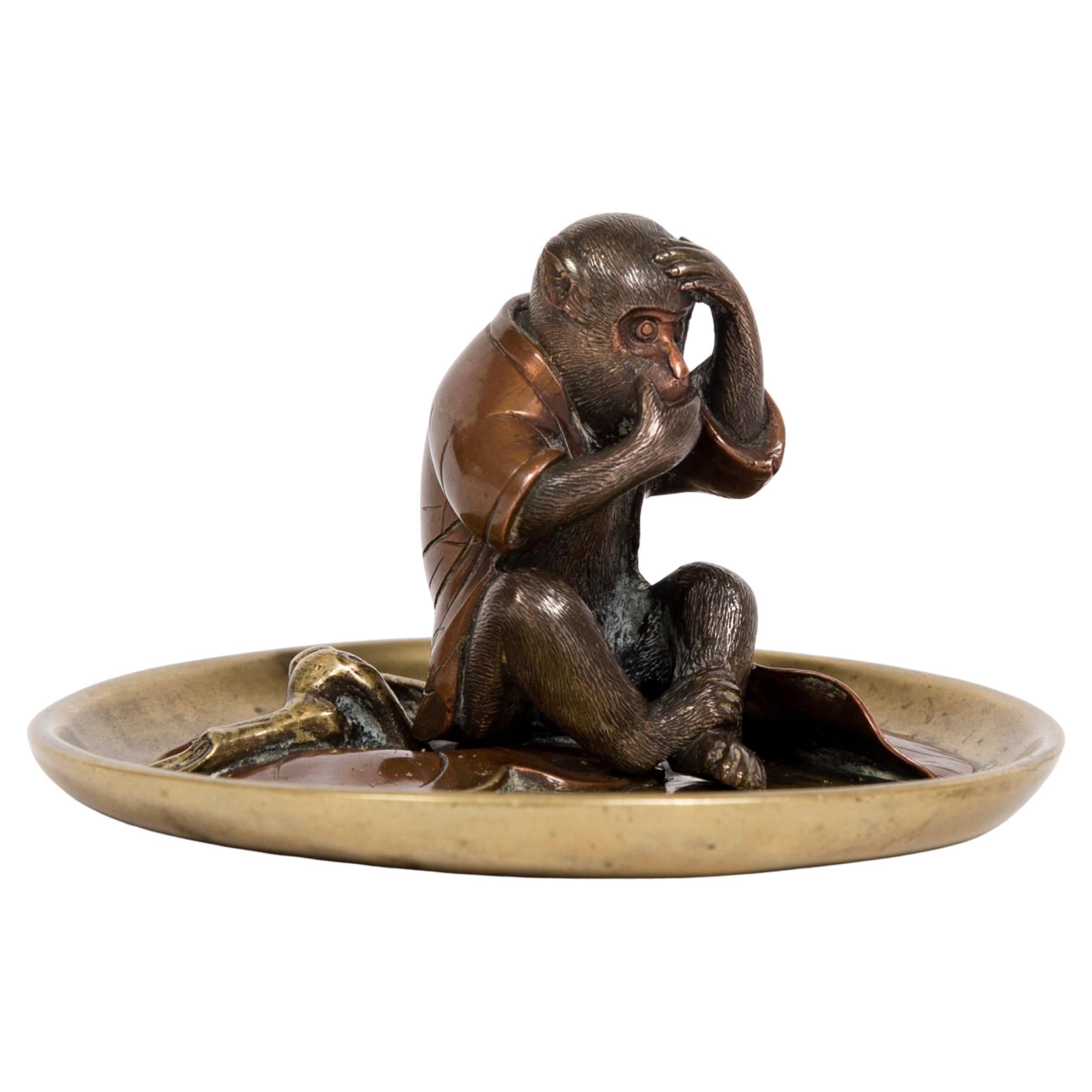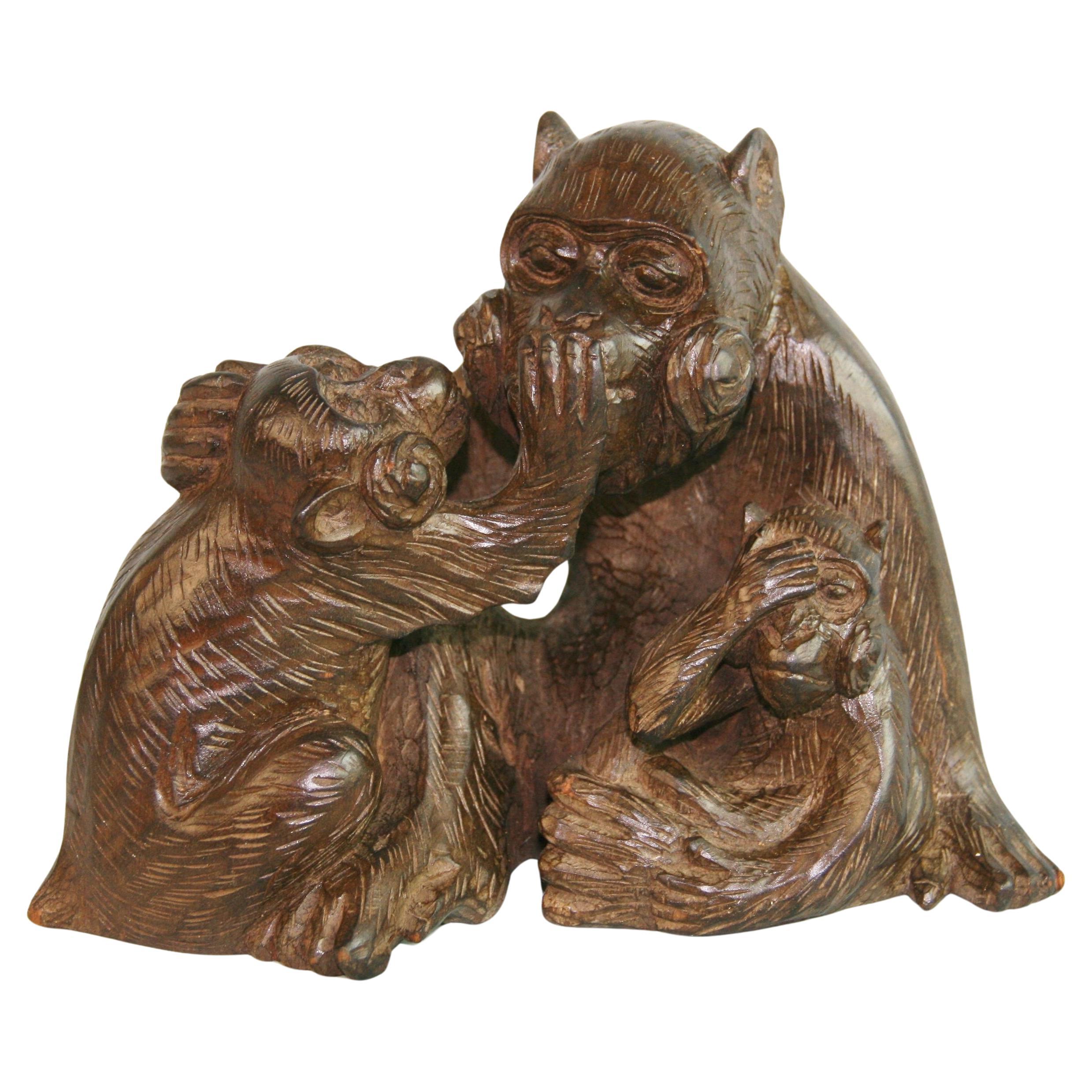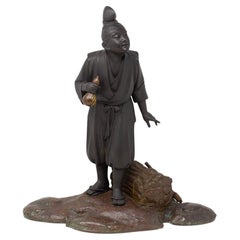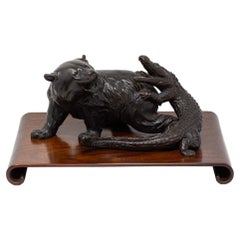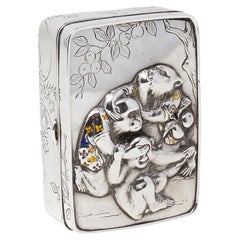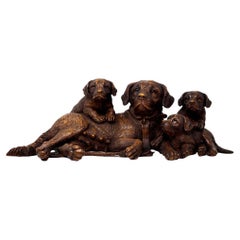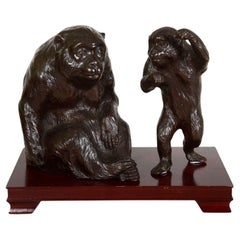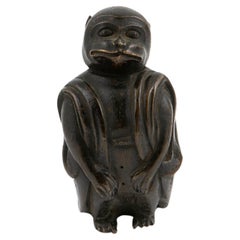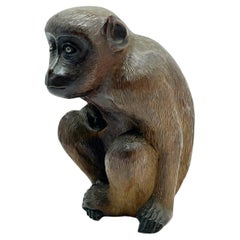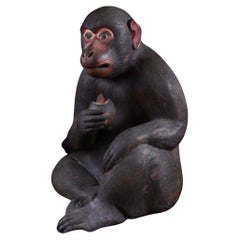Items Similar to Japanese Meiji Period Bronze Monkey Group Sculpture Okimono Shosai
Want more images or videos?
Request additional images or videos from the seller
1 of 21
Japanese Meiji Period Bronze Monkey Group Sculpture Okimono Shosai
$20,440.20
£15,000
€17,679.01
CA$28,131.54
A$31,355.53
CHF 16,451.17
MX$382,902.16
NOK 208,307.60
SEK 196,882.37
DKK 131,946.19
About the Item
Featuring Seven Japanese Macaques
Form our Japanese collection, we are delighted to offer this Japanese Bronze Monkey Group by Shosai. The Japanese Bronze Group displaying a male father monkey and his infants playing around and being mischievous with Persimmon fruit. The monkeys modelled as Japanese macaque monkeys (snow monkey). The bronze okimono is beautifully patinated with a highly lifelike and naturalistic casting signed to the underside Shosai 正齊鋳. The Bronze group dates to the Meiji Period (1868-1912) circa 1885.
Japanese macaque (snow monkey) is a terrestrial Old World monkey species that is native to Japan. They are known as snow monkeys because some live in areas where snow covers the ground for long periods each year hence their nickname. No other non-human primate lives further north or in a colder climate than the snow monkey. Individuals have brownish grey fur, pinkish-red faces, and short tails. Two subspecies are known and their conservation Status is of least concern. In Japan, the species is known as Nihonzaru ニホンザル, 日本 (Japan/Nihon) and saru 猿 (monkey) to distinguish it from other primates, but the Japanese macaque is the only species of monkey in Japan.
The Japanese macaque features heavily in the religion, folklore, and art of Japan, as well as in proverbs and idiomatic expressions in the Japanese language. They are often seen in paintings, block prints and represented in all manner of carvings from Okimono to netsuke. Many of these art forms reside in the world’s most famous museums and collections, some of the most prominent pieces by artists such as Mori Sosen and Kawanabe Kyosai. In Shinto belief (Japan’s indigenous religion/nature religion) legendary mythical beasts known as raiju sometimes appeared as monkeys and kept Raijin (the god of lightning/storms) company. In another well known tale the three wise monkeys who warn people to “see no evil, hear no evil and speak no evil” can be seen depicted in relief over the door of the famous Tosho-gu shrine in Nikko.
Meiji Period was an era of Japanese history that spanned from 1868 to 1912. It was the first half of the Empire of Japan, when the Japanese people began to build a paradigm of a modern, industrialised nation state and emergent great power, influenced by Western countries and aesthetics. As a result of radically different ideas, the changes to Japan were profound and it affected the social structure, politics, economy, military, and foreign relations across the board. The period corresponded to the reign of Emperor Meiji and was preceded by the Keio era and was succeeded by the Taisho era.
Cultural Art during the Meiji Period was of particular interest to the government and they overhauled the art export market which in turn promoted Japanese arts via various world’s fairs, beginning in Vienna at the world fair in 1873. The government heavily funded the fairs and took an active role organising how Japan’s culture was presented to the world including creating a semi-public company named Kiritsu Kosho Kaisha (First Industrial Manufacturing Company). The Kiritsu Kosho Kaisha was used to promote and commercialise exports of Japanese art and established the Hakurankai Jimukyoku (Exhibition Bureau) to maintain quality standards. For the 1876 Centennial International Exhibition in Philadelphia, the Japanese government created a Centennial Office and sent a special envoy to secure space for the 30,000 items that would be displayed. The Imperial Household also took an active interest in arts and crafts, commissioning works by select artists to be given as gifts for foreign dignitaries further emphasising the high quality and importance of Japanese art. Just before the end of the 19th century in 1890, the Teishitsu Gigeiin (Artist to the Imperial Household) system was created to recognise distinguished artists. These artists were selected for their exceptionally high quality wares and talent in their own industry. Over a period of 54 years Seventy artists were appointed, amongst these were ceramicist Makuzu Kozan and cloisonné enamel artist Namikawa Yasuyuki.
Bronze an alloy consisting primarily of copper with approximately 12–12.5% tin and often with the addition of other metals (including aluminium, manganese, nickel, or zinc) and sometimes non-metals, such as phosphorus, or metalloids such as arsenic or silicon depending on the age of the bronze and its origin. The additions of other metals produce a range of alloys that are usually harder than copper alone and carry useful properties such as strength. The earliest known use of bronze dates to the 5th millennium BCE from Iranian plateau, the bronze mix consists of arsenical copper and copper-arsenide. The earliest tin-copper-alloy recovered is dated to circa 4650 BCE and was found in Plocnik, Serbia. It is believed to have been smelted from a natural tin-copper ore.
Antique a collectable object such as a piece of furniture or work of art that has a high value because of its age and quality. Objects of this nature are generally considered antique at 100 plus years of age.
- Dimensions:Height: 5.12 in (13 cm)Width: 7.09 in (18 cm)Depth: 6.3 in (16 cm)
- Style:Meiji (Of the Period)
- Materials and Techniques:
- Place of Origin:
- Period:
- Date of Manufacture:Circa 1885
- Condition:
- Seller Location:Newark, GB
- Reference Number:Seller: KADDS1stDibs: LU6971240496452
About the Seller
5.0
Gold Seller
Premium sellers maintaining a 4.3+ rating and 24-hour response times
Established in 2019
1stDibs seller since 2022
37 sales on 1stDibs
Typical response time: 3 hours
- ShippingRetrieving quote...Shipping from: Newark, United Kingdom
- Return Policy
Authenticity Guarantee
In the unlikely event there’s an issue with an item’s authenticity, contact us within 1 year for a full refund. DetailsMoney-Back Guarantee
If your item is not as described, is damaged in transit, or does not arrive, contact us within 7 days for a full refund. Details24-Hour Cancellation
You have a 24-hour grace period in which to reconsider your purchase, with no questions asked.Vetted Professional Sellers
Our world-class sellers must adhere to strict standards for service and quality, maintaining the integrity of our listings.Price-Match Guarantee
If you find that a seller listed the same item for a lower price elsewhere, we’ll match it.Trusted Global Delivery
Our best-in-class carrier network provides specialized shipping options worldwide, including custom delivery.More From This Seller
View AllJapanese Bronze Okimono Sculpture by Yamamoto Kozan
Located in Newark, England
YOUNG MAN WOOD CUTTING
From our Japanese collection, we are pleased to offer this Japanese Bronze Okimono by Yamamoto Kozan. The Japanese Bronze Sculpture cast in Bronze with a natu...
Category
Early 20th Century Japanese Meiji Sculptures and Carvings
Materials
Bronze
Japanese Meiji Period Bronze Group Bear & Alligator by Yoshimitsu
Located in Newark, England
The Japanese group comprises of a Bear being attacked by a large alligator. The alligator jumping on the back of the Bear with mouth wide opening showing its razor sharp teeth. The b...
Category
Antique Late 19th Century Japanese Meiji Animal Sculptures
Materials
Bronze
Antique Japanese Meiji Silver & Enamel Box Three Wise Monkeys Komyo, Uyeda
By K. Uyeda
Located in Newark, England
Japanese Silver & Enamel
From our Japanese collection, we are delighted to offer this Japanese Silver Box by Komyo 光明. The Silver box of rectangular form with rounded corners featur...
Category
Early 20th Century Japanese Meiji Metalwork
Materials
Silver, Enamel
Swiss Black Forest Dog Group Walter Mader (attributed)
By Walter Mäder
Located in Newark, England
Featuring a Dog with Pups
Rare Swiss Black Forest Dog group. The group modelled as a smooth coat St. Bernard female with her three puppies. The...
Category
Antique Early 1900s Swiss Black Forest Animal Sculptures
Materials
Wood
Japanese Bronze Pheasant Okimono Genryusai Seiya
Located in Newark, England
Unusual Casting of a Pheasant in Flight
From our Japanese collection, we are delighted to offer this Japanese bronze okimono of a Pheasant upon a naturalistic root wood base. The Ph...
Category
Antique Late 19th Century Japanese Meiji Sculptures and Carvings
Materials
Bronze
Rare Model Swiss Black Forest Bear Tobacco Jar
By Black Forest
Located in Newark, England
Rare and Unique Model
From our Black Forest collection, we are delighted to introduce this rare example Swiss Black Forest Bear Tobacco Jar. The Bear Tobacco Jar carved from Linden ...
Category
Antique Late 19th Century Swiss Black Forest Animal Sculptures
Materials
Wood
You May Also Like
Meiji period Japanese bronze Monkeys.
Located in Brighton, Sussex
These exquisite Japanese Meiji period sculptures depict two patinated bronze monkeys, showcasing the artistry and craftsmanship of the era. The larger monkey, seated with a contempla...
Category
Antique Late 19th Century Japanese Sculptures and Carvings
Materials
Bronze
Small Meiji Period Japanese Bronze Monkey Sculpture
Located in Kastrup, DK
Small Japanese bronze sculpture in the form of a monkey with intricate details
Finely crafted in dark-patinated bronze with a rich patina.
Dating from the Meiji period (1868-1912) o...
Category
Antique Late 19th Century Japanese Meiji Animal Sculptures
Materials
Bronze
19th Century 'Meiji Period' Japanese Carved Wood Seated Monkey Sculpture
Located in North Miami, FL
19th Century (Meiji Period) Japanese hand-carved wood seated monkey. The eyes are inlaid and made of glass. The fur and details are very realistic. The piece is signed on the bottom ...
Category
Antique 19th Century Japanese Meiji Animal Sculptures
Materials
Glass, Wood
Rare Edo Period traditional Dojin-yaki finely Carved Monkey Figurine
Located in Fukuoka, JP
This exceptional Edo-period sculpture depicts a seated monkey in an incredibly lifelike manner, with finely carved details and expressive features. Made using traditional Dojin-yaki ...
Category
Antique 18th Century Japanese Edo Sculptures and Carvings
Materials
Clay
Japanese Monkey Suaka
Located in PARIS, FR
Bronze sculpture of a monkey laying on a golden brass tray adorned with copper
leaves. This sculpture is made of sentoku and shibuchi bronze with a very interesting
suaka patina.
...
Category
Antique Late 19th Century Japanese Sculptures and Carvings
Materials
Bronze
$2,122
Japanese Hand Carved Monkey Family Sculpture Hear, See and Speak No Emil
Located in Douglas Manor, NY
1276 Japanese hand carved hardwood monkey family sculpture.
Fine detail.
Category
Mid-20th Century Sculptures and Carvings
Materials
Hardwood
More Ways To Browse
Emperor Japan
Japanese Bronze Sculptures
Monkey Sculptures
Tinned Copper
Japanese Metal Sculpture
Antique Monkey Art
Two Monkeys
Relief Sculpture Face
Gold Monkey
Antique Tinned Copper
Antique Tin Can
Antique Tin Cans
Copper Relief Sculpture
Centennial 1876
Alloy Sculpture
Japanese Cloisonne Bronze
Bronze Monkey
Meiji Bronze Sculptures
